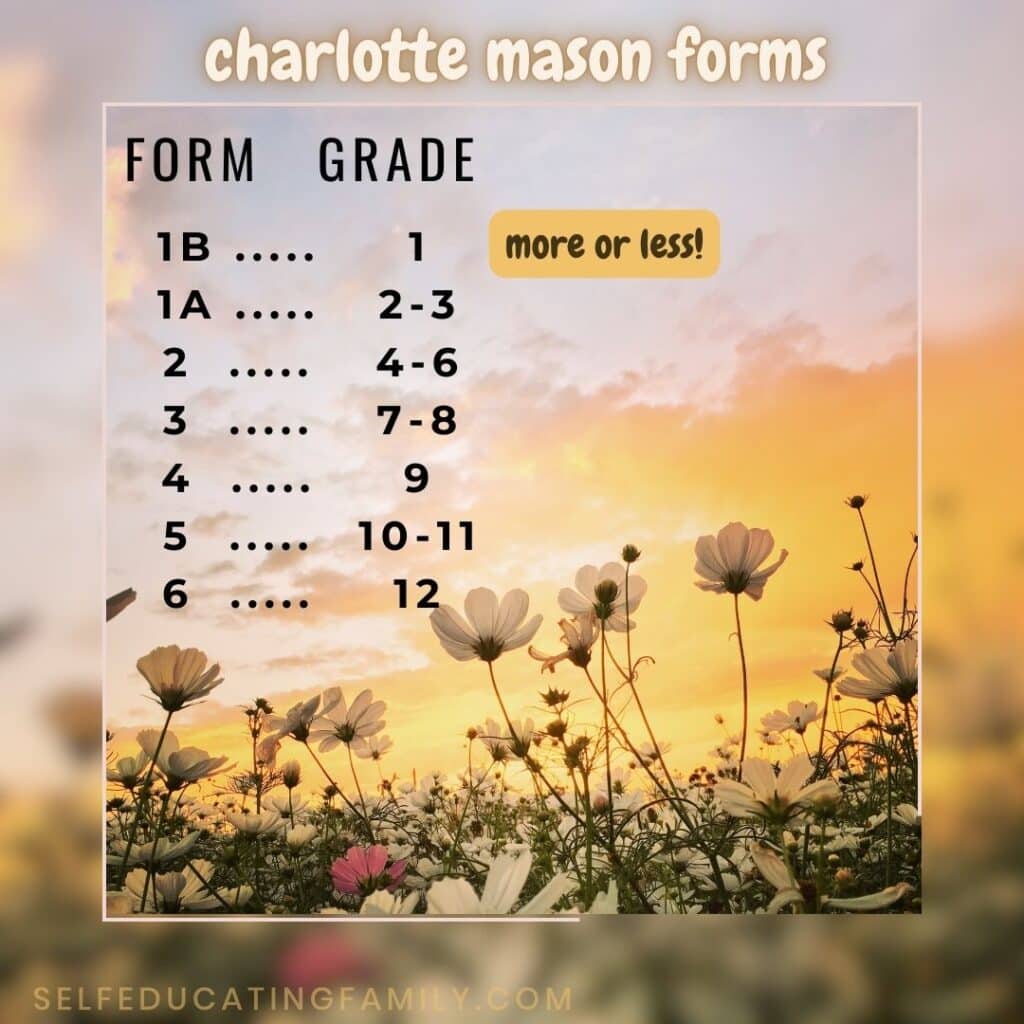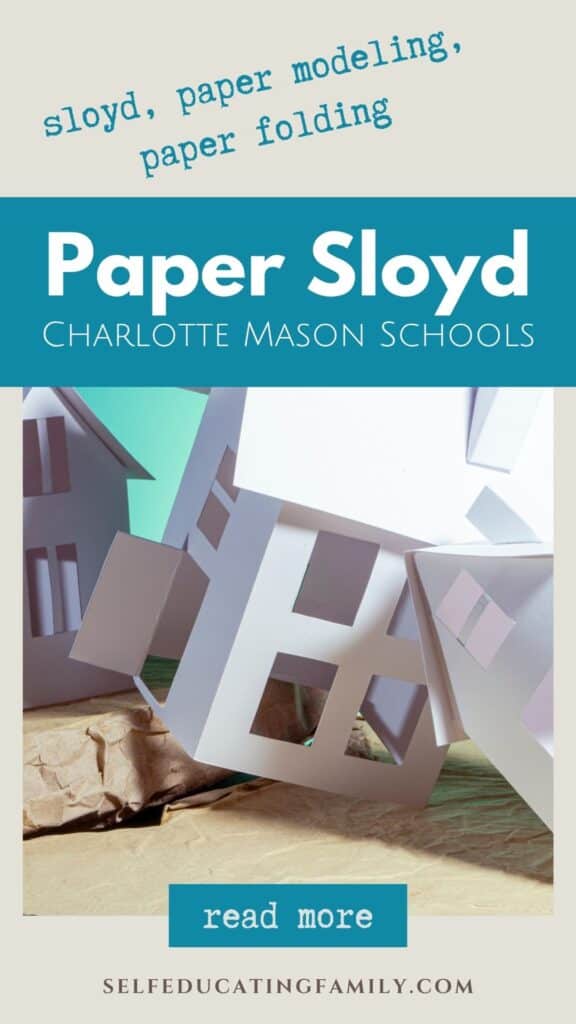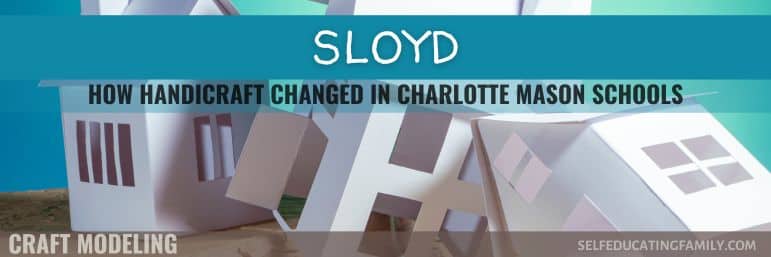What’s inside: Here’s the story on how Paper Sloyd developed over the history of Charlotte Mason schools in Ambleside England. See how changes back then relate to your first graders today.
Charlotte Mason Schools
Charlotte Mason Schools in Ambleside, England incorporated Sloyd and Sloyd principles because they aligned with her philosophy of education.
Sloyd: noun. A system of manual training developed in Sweden, based on the use of tools in woodworking.
At Ambleside, Sloyd was also called handicraft, hand craft, and sometimes “work”.
Why handicraft (or Sloyd)?
If you’ve read any of my posts, you know I love teaching handicraft to kids.
- When done right, handicraft empowers kids by giving them the confidence of mastering a skill. They can look at something and think, “I made that!”
- The real brilliance of handicraft is that it builds character habits as it trains the children to execute and examine their own work. So a kid focuses his attention on what needs to be done (habit of attention), takes care to execute carefully (habit of self-control over what is being done), and then checks his work (habit of observation).
- Handicraft is usually done in the afternoon during “masterful inactivity” times, so that the child becomes self-directed and doesn’t fall into the “I’m bored” pit.
- Handicraft builds over time. All ages can participate and learn at their own level. And they keep building skills each year.
Charlotte Mason (CM) and Paper Sloyd
You’ve also heard me expound on how Charlotte Mason homeschooling incorporates handicraft as a subject.
Let’s look specifically on how she did this in her own schools.
Sloyd
Sloyd was evolving in Finland and Sweden just before Charlotte started teacher training for Ambleside schools.
- 1860s – Finland & Sweden implement Sloyd in their school systems
- 1890s – House of Education established for training teachers at Ambleside schools
Swedish Sloyd generally means woodcraft lessons that start simply and progress through a series of models with the child doing all of the work and the teacher demonstrating as needed.
Sloyd was adopted by both the Ambleside schools in England and by the North Bennet Street Industrial School in Boston. (Sadly, most public schools in the US did not adopt Sloyd, instead opting for the Russian system of Industrial Arts, which helped train workers for the Industrial Revolution, but that’s another story!)
“The general aim of Sloyd, then, is the moral, mental, and physical development of the pupil, the mental development being secured by help of the physical.” – Gustaf Larsson
My contention is that the formative aims of Sloyd are pretty much in line with the formative aims of what we want for our kids when we homeschool, with the addition of the academic subjects, of course.
Staying within the Compass
Yet here is the trickiest part of teaching Sloyd.
(Or one of the trickiest.)
You, as the teacher, must know what each child is capable of doing. Pushing a bit, but not too much, so that you maximize learning while keeping it within reach and not frustrating.
This concept is called “Staying within the Compass”, as coined by Charlotte.
“Forms”: Or what we know as “What Grade are you in?”
Ambleside Schools organized children into Forms 1 through 6, while the current American system uses Grades 1-12 for the same ages.

Mastery was expected before you could move to the next form, but without the stigma of being “left back”. Often, children would be in different forms for different subjects, much like homeschooling – for instance, if you have a child gifted in Math, you advance the child in that subject.
In CM schools, Form 1B was roughly first grade and Form 1A was roughly second and third grade.
Evolution of Handicraft in CM Schools
When CM schools started embracing Sloyd, they did so with woodcraft modeling, just as in Sweden and Finland. Children were familiar with knives at that time from a young age. Ambleside also experimented with other Sloyd areas, but again, that’s another story!
Wood Sloyd was eventually replaced with Cardboard Modeling. And then Paper Modeling.
But what Miss Mason discovered, as do many homeschooling moms today, is that Form 1A (first grade – age 6 or 7) usually has not developed hand coordination for cutting precision lines required for Paper Modeling.
Most Paper Models start by having the child cut a perfectly square piece of paper.
But kids that age couldn’t keep the lines straight.
It was outside the reach of their compass.
So CM schools turned to Paper Folding for the youngest ages. Where you start with a pre-made, already cut-for-you perfect square.
Summary of Progression of Paper Sloyd in CM Schools
- Wood Sloyd
- Cardboard Modeling
- Paper Modeling
- Paper Folding
How does this help us today?
We can apply these principles to teaching handicraft today.
Principles of Sloyd as applied to Handicraft
We need to keep the following principles in mind:
- Stay within the child’s compass.
- Start simple and build skills.
- Child does all the work.
- Challenging, but not too challenging.
- Have the child evaluate their own work.
- Make sure they aren’t being too perfectionist, but that they are doing it correctly and to their satisfaction.
- Work carefully with complete focus.
- No slipshod work.








